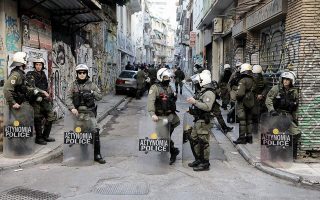Norman Atlantic charge sheet spells out negligence

Crew members abandoned their posts, fire emergency plans were mistakenly activated for Deck 3 instead of Deck 4 where the blaze had broken out, and a lifeboat was released into the sea before the evacuation order had been issued or any safety measures taken. The indictment submitted by Italian judicial authorities for the criminal trial regarding the Norman Atlantic ferryboat tragedy, which has been seen by Kathimerini, describes an absence of coordination and a string of mistakes and oversights in the handling of the fire. The trial is set to start on May 6 in the Italian city of Bitondo.
In the early hours of December 28, 2014, the passengers of the Norman Atlantic woke up to the smell of smoke and burning plastic. The ship was en route from Patra to Ancona in Italy, having stopped briefly at Igoumenitsa on Greece’s western coast. There were 56 Italian and Greek crew members on board and more than 400 passengers. It was in the Adriatic Sea, crossing the Strait of Otranto, when a fire broke out on one of the vehicle decks. The rescue effort took 36 hours, and the toll by the end was 11 dead and more than 10 missing. Some of the victims burned to death after getting trapped in their cars, others perished at sea as they tried to save themselves. In at least two cases, DNA analysis was needed to identify the bodies, months after the incident.
The indictment names 30 suspects (nine of whom are Greek) from the two companies responsible for the vessel, owner Visemar and charterer ANEK, including executives, the ship’s captain and several of its officers and crew. Greece’s ANEK did not respond to a request for comment by Kathimerini.
Accusations
The oversights appear to have started even before the Norman Atlantic left the western Greek port of Patra, as the Italian captain’s manifest did not include the names of all the passengers on board, as required by law. The main part of the indictment, however, concerns apparent negligence while the ship was being loaded, particularly the fact that several trucks were allowed to leave their engines running once the Norman Atlantic was at sea and that its cargo was not correctly distributed. The vehicles were placed too close to each other, in violation of safety rules, which required at least 40 centimeters of space between them. This meant that the crewman responsible for patrolling the car decks was unable to move between the vehicles and could not properly carry out inspections for fire or any other problems.
The Italian indictment puts names to the charges. The first mechanic, an Italian, allowed an inexperience Greek electrician, who was a trainee, to hook up the refrigerator trucks to the ship’s electrical supply, and then abandoned his post when the fire broke out without informing in the captain.
In another instance, an Italian officer who was on duty on the bridge from 2 to 6 a.m. did not notify the captain at once when he saw smoke coming from Deck 4. Another four Italian suspects are accused of mobilizing the drencher system on Deck 3 instead of Deck 4 when the fire started. One factor that may be to blame for this error was the ship’s plans, which were the responsibility of the Italian owner Visemar, where the decks were not given numbers but names. Deck 4, for example, was described as the “weather deck.” According to the charge sheet, this mix-up allowed the fire to spread and to black out the ship’s electrical systems, meaning that the crew was no longer in full control of the vessel.
Survivors who spoke to Kathimerini in the wake of the incident reported that they didn’t hear an alarm ring when the first broke out. The charge sheet claims that two Greek stewards alerted passengers on Deck 6, but not those on decks 5 and 7. Another crewman, an Italian, abandoned the ship in a lifeboat when he should have been overseeing the evacuation of the vehicle decks. The Norman Atlantic’s cook was late turning up at his post to distribute life vests and is also accused of leaving the ship in a lifeboat before completing his duties. Another left his post in the engine room, took a life jacket from Deck 5 and climbed up to Deck 7 with passengers to wait for a rescue helicopter.
Yet another crew member who should have been helping prepare the lifeboats and getting passengers into them instead chose to go to his cabin to get his personal belongings, according to prosecutors.
The use of the ship’s lifeboats appears to have violated numerous regulations, while the indictment further claims that the evacuation protocol did not warn of the risks of dropping the vessels from a height. Such safety measures were flouted on several occasions, passengers were not properly guided to the boats and at least one vessel was dropped into the sea without the captain’s green light.
In the investigation into the incident, Italian experts found that at least one lifeboat was allowed to leave with fewer than the 150 passengers it was designed to accommodate. They then spent 45 minutes at sea before being able to approach the Spirit of Piraeus, a container ship which had responded to the Norman Atlantic’s SOS. Two of the lifeboat’s passengers were lost at sea while trying to climb the ladder onto the vessel.
The indictment is particularly critical of failures regarding the marine evacuation system, claiming that it was mobilized by crew members who had not been adequately trained in its use and who directed passengers to the escape chute without ensuring there was a raft for them to land on. Two people died as a result, the charge sheet claims.
Mention is also made of the Norman Atlantic’s structure, with the indictment claiming that air coming in from openings on Deck 4 prevented the smoke and heat detection system from kicking in immediately, thus contributing to the rapid spread of the fire.
The same issue is brought up in a lawsuit filed by a group of survivors seeking damages. They claim that the blaze was stoked by the air coming in from the openings, turning the vehicle deck into an oven.
Compensation suits
Apart from the criminal trial that is due to start in May, there are also several lawsuits for damages pending, more than four years after the tragedy occurred. It is estimated that 65 percent of the passengers came to some form of settlement with the two companies within the first two years after the incident. On December 2016, 105 plaintiffs, including 49 passengers and relatives of seven victims, filed suit with a court in Italy.
The destruction on the Norman Atlantic was so extensive that it took years before experts could fully investigate it and remove all the vehicles from the ship. The last traces of the fire were put out on January 12, 2015. On February 3, a charred body was discovered in the wreckage of Deck 4. On October 6, experts were able to retrieve conversations between crew members during the fire from the voyage data recorder. The experts’ report was filed with Italian judicial authorities in January 2017. In it, they claim to have found flaws and compelling signs of human error at every level of the Norman Atlantic’s emergency response and management system.





